Mangrovia
- Designer: Eilif Svensson
- Publisher: Zoch
- Players: 2-5
- Ages: 10+
- Time: 60-90 mins
- Times played: 8, with review copy provided by Zoch Games
We’re just about to the end of the Essen 2014 reviews, and I’ve saved one of the best for last this time around. The Zoch press event is one of the highlights of the pre-show activities at Essen, traditionally on the Wednesday afternoon on the show floor. It’s one of the first chances to meet up with old friends, a nice chance to get some good food and drink, and of course, a great chance to learn about and play the new Zoch games.
This year, I was very excited about Mangrovia. I had just met the designer of the game, Eilif Svensson, earlier in the day to discuss his other Essen release (Doodle City), and he was gracious enough to teach me the rules to his big box release at the Zoch stand as well.
In Mangrovia, players act as tribe members vying for the role of becoming the new chief of their tropical paradise. The board shows a map of their living area, both land and water areas. There are some special areas in Mangrovia – two square areas (the stone area and the pole area) as well as the divine paths (4 horizontal rows and 4 vertical columns).
Each player starts with a number of huts (9 in a 4p game) as well as a pair of starting number cards. The number cards vary in value from 2 to 7, and each player in turn order receives a cumulative value in their starting cards that is one more than the previous player.
Each player also receives two landscape cards at random from the deck. There are four different landscape types in the game: mangrove, water, sand and meadow. In the upper left portion of the board, there is a square grid of the landscape types, and two wooden birds of paradise are placed on the mangrove and water spaces. Each player is also given a wooden bowl which will be used to choose their actions each turn.
The game is played over a number of rounds until the endgame condition is met – namely when at least one player has played all of his huts to the board. Each round follows the same three phases: choosing actions, performing actions, and clean-up.
To choose actions, players take turns (starting from the current start player and then moving clockwise) placing their bowl somewhere on the action track. In the bottom right corner of the board, you will see a “track” of twelve possible actions – organized in pairs (1 & 12, 2 & 11, 3 & 10…) such that two columns of 6 are formed. There is a space between each of the pairs of actions where players can place their bowl. Placing a bowl claims both of the actions adjacent to the bowl. Each player places their bowl on an available space in this phase with the exception that the first player cannot choose the top most space (as this is the one which determines first player for the next turn).
In the second phase, the 12 actions from the track are now executed. There is a boat that moves counter clockwise around the track – and as it moves around, the action which is next to the boat is performed by the player whose boat is on the landing space next to the action.
There are four different types of actions that you might be able to do – the icons on each action space tell you which ones to do.
Move the birds of paradise (Action #12): pick up the two birds of paradise and place them back on any two spaces in the area (could even be the same spaces that they came from). This player also becomes the start player for the next round.
Draw cards (#1, 3, 4, 5, 6, 7, 11) – there are two displays of cards available each round: 4 face up number cards and 3 face up landscape cards at the start of each round. A white card icon tells you to choose one of the available remaining face up cards (the face up display is not replenished until the end of round) while a grey card icon tells you to take a face down card from either deck. You must follow the order of the icons on the action space.
Place huts (# 8, 9, 10, 11) – you may build a hut on a free board space – but there are a lot of rules/conditions. First, you may only build on one of the two landscape types that the birds of paradise are currently sitting on. Second, you must be able to pay the EXACT costs of the space (which can be either in number cards or in amulets) as well as discarding a landscape card that matches the space on which you are building. If you can pay these costs, you place your hut on your chosen space. Most of the spaces have VP icons on them, and you immediately score points equal to those printed on the space. If you build in the pole area (lower portion of the board), you take the lowest numbered vp token available in that area to place under your hut. You also score VPs equal to the number on this token.
There is one space that allows you to build a double hut (2 huts in the same space) – if you do so, you must be able to pay exactly twice the costs. You are not obligated to build a double hut, but this is the only chance to do so. You receive double the VPs if you place a double hut – however, you may not build a double hut in the pole area, the stone area or on any amulet track space.
Collect amulets (# 2, 7, 8) – Based on your position on the amulet track, found in the lower left portion of the board, you can draw anywhere from 1 to 5 amulets.
Draw amulets – Depending on your status on the amulet track, found in the lower left portion of the board, you can draw anywhere from 1 to 5 amulets. At the start of the game, you are in the lowest position which only allows you to draw an amulet of value 1 from a face up stack. Otherwise, you draw amulets out of a bag with values varying from 2 to 6. If you draw 2 or more amulets, you always look at what you have drawn and then return exactly one of those to the bag, keeping the rest. You can improve your position on the amulet track by building a hut on an amulet space on the board, namely the 10 spaces that have red circles around them.
Again, the boat moves around the track, and stops at each action space where there is a player bowl next to it. If no one has occupied an action space, that action is simply skipped.
Once all the actions are taken (and the boat has made a full revolution around the board), you check to see if the game is over – i.e. if any player has played his final hut. If so, you move into final scoring. If not, you perform the third phase of the round which is to cet up the board for the next turn. First, you check to see if anyone took action #12 (birds of paradise + first player). If not, the first player token moves on player to the RIGHT. Additionally, the birds of paradise move to the opposite two spaces as the previous round. Then, the two card displays are replenished back up to 4 number cards and 3 landscape cards. Players take back their bowls so they can be placed again in the next round.
Final scoring
During the game, players have scored points for placing huts in spaces and collecting VPs as printed on those spaces. They have also scored additional points for placing huts in the pole area (according to the token placed at the time of the build). In the final scoring, there are 4 more ways to score points.
First, you look at the 8 divine paths – these are the left most 4 columns and the topmost 4 rows on the board. Each of them have score values for first and second place on them. These points are awarded to the player who has the most huts in that row or column. Ties are broken by whichever player is closer to the start of the row/column.
Then, the stone area is scored. These 8 spaces do not score any points during the game when you build huts there. Instead, at the end of the game, each of these spaces is worth a number of points equal to the total number of all huts in the stone area (max 8 VPs per hut).
Third, the pole area is scored for most huts similar to the 8 divine paths. The player with the most and second most score points. Ties go to the player who had built there the earliest (and thus has the lowest pole VP token under their hut).
Finally, any amulets left over are worth their numerical value in points (again, ranging from 1 to 6 VPs per amulet token).
The player with the most points wins. Ties go to the player with the highest amulet total at the end of the game.
My thoughts on the game
As I alluded to in the opening of the review, I think this is one of the best games from the 2014 Essen show. Though I haven’t played any of the Nuremberg games yet, it is on my personal shortlist for the Kennerspiel des Jahres award (of course, I have no vote nor influence over this award).
There is a lot to think about as you try to figure out how to succeed in this game. The victory points come from placing your huts, though the locations of those huts can greatly modify your bonus point total in the endgame scoring. It is not uncommon to see players gain more than half of their total points in the endgame scoring.
So, trying to group your huts in a way that generates bonus points is clearly a concern. However, the cards you have might not match up to the available spaces – OR the birds of paradise might not be on the correct landscape tile this turn. Then, you’re faced with a different decision – do you wait on building until you can place a hut in the optimal space, or do you build on the current turn to get your huts on the board. But, if you wait too long, you might lose your opportunity to place huts at all because the game will end when any player places his last hut on the board or perhaps the turn order will be different in the next round, and an opponent might beat you to the spot you want to build on in that next turn.
Timing can also be crucial when trying to choose which card drawing action to take. The best card drawing actions come at #1 and #6. It makes sense for #1 to be good because you only get to take start player and move the birds. You also could get 3 cards at #6, but your choices will be much more limited. As the displays are not replenished until the end of the turn, you will have to choose how early in order you want to go – you will get fewer cards earlier in the order, but you then stand a better chance of drawing the card you want from the face up display.
If you have kept track of what other people are drawing (or could draw), that might also modify your decision of where to place your bowl as you might want to build before someone else to ensure that you get the spot that you want. The double hut and the double build are also later in the order, so if you want to try to get two huts out on a turn, you’ll have to hope that someone doesn’t swoop in before you to take your spots.
Once you have chosen when to build – then the options of where to build follow. We’ve found that the stone area is always popular in our group. It is rare for less than 7 of the 8 spots to be built out here, and when that happens these turn out to be some of the most valuable spaces on the board. But, the relative value of other spaces can also be high, especially if you are able to gain a first place bonus in a divine path with only a few huts.
These many variables keeps gameplay open and has you constantly searching the board to calculate which places will be most beneficial for you to build in, and thus, which number cards/amulets/landscapes you need to collect.
Though any particular turn can take a bit of thinking, the game itself moves along at a quick pace. I’ve never felt like the game dragged on. For me, the biggest time investment comes when trying to choose where I want to place my bowl – it’s important to try to figure out what you want to do as well as what your opponents might want to do so that you can take the best action you can at the best time possible.
The components are nice, the huts and bowl are solid wooden spinnings, the sort you’d expect in a nice game. The artwork on the board and cards is well done and the layout is clear. The rules are good with clear examples. I only have one nitpick thing with the rules, specifically about where you cannot place double hut – we often miss this rule. It would have been nice (for me) to have a “no double hut” icon on those spaces or have the rule be even more emphasized in the rules.
Mangrovia has turned into one of my go-to games from the Essen 2014 set. While I have introduced this to a beginning gamer, and they were able to pick up the gist of the rules/mechanics quickly, I feel that it is definitely a game for the more veteran gamers as there are a lot of decisions that need to be made. Success will come from a combination of good long term planning for the bonus scores balanced with taking advantage of some tactical opportunities when the cards line up right.
Thoughts from Other Opinionated Gamers
Lorna: Mangrovia turned out to be surprisingly popular at my convention, EGG and at a few game nights I had. It worked quite well for those that like a nice middle weight game. We have only played the basic game and there is luck with the little amulet drawing and the card but overall the game provides a nice set of choices to make.
Jonathan F.: I’m just not an area majority person, so this game, while beautiful, elegant, and well constructed, did not captivate me. I respect it and expect that most players will enjoy it, especially if they liked Eight-Minute Empire, Rococo, or the end game of Ginkgopolis
Greg S: I do like area majority games, but this one felt just so-so to me. It didn’t capture my imagination. It was, as my good friend and fellow Jim McDanold likes to say, “Fine.” With Jim, that is a kiss of death, as he will likely never play it again. For me, it means it is OK, but I have no strong desire to play it.
Jay B: The action track is well designed and there is genuine tension in the trade offs between getting cards and amulets, building huts, and turn order. Beyond that though, I think the underlying area majority mechanism is pretty (ironically) dry, conventional, and soulless.
Ratings from the Opinionated Gamers
- I love it! Dale Y, Erik A
- I like it. Luke H, Lorna, Geske, Rick T, John P, Craig M
- Neutral. Dan B, Jonathan F, Joe H, Brian L, Jay B
- Not for me…

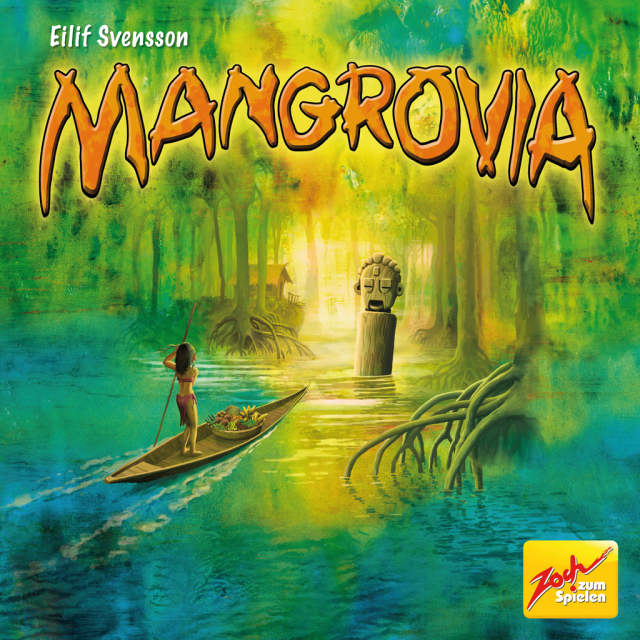
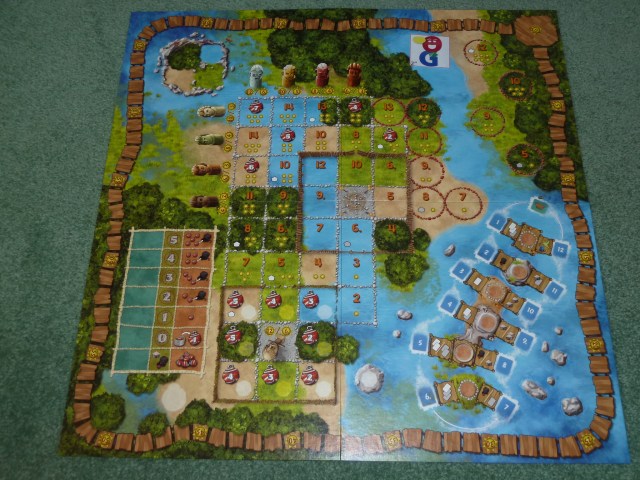

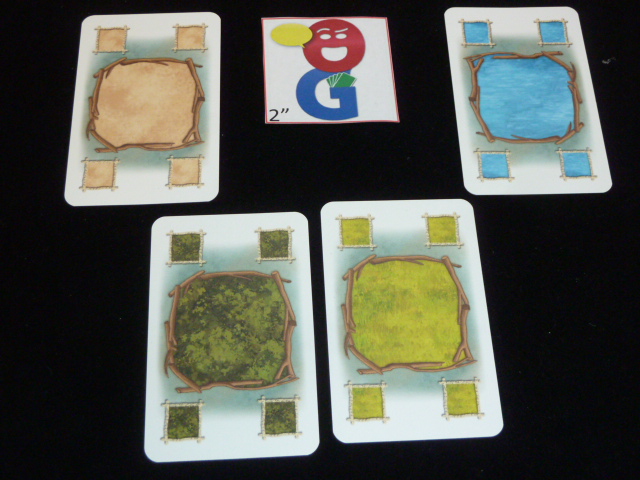
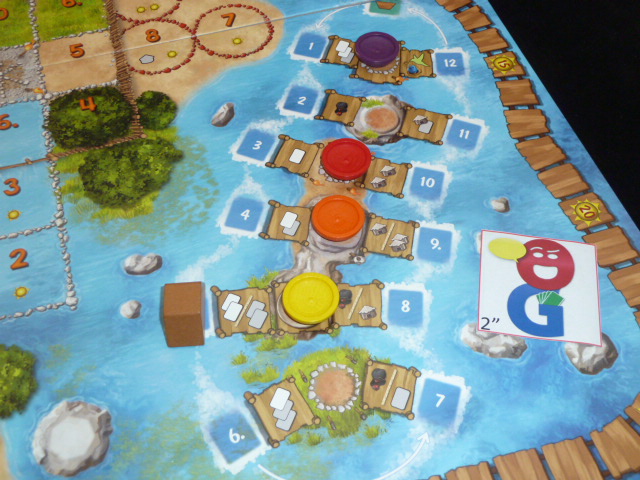

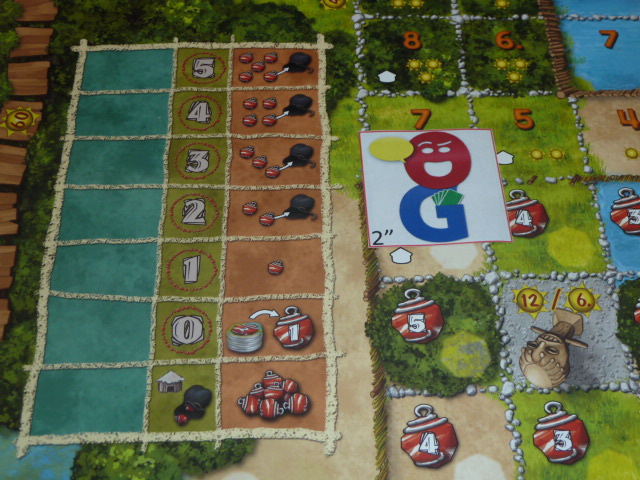
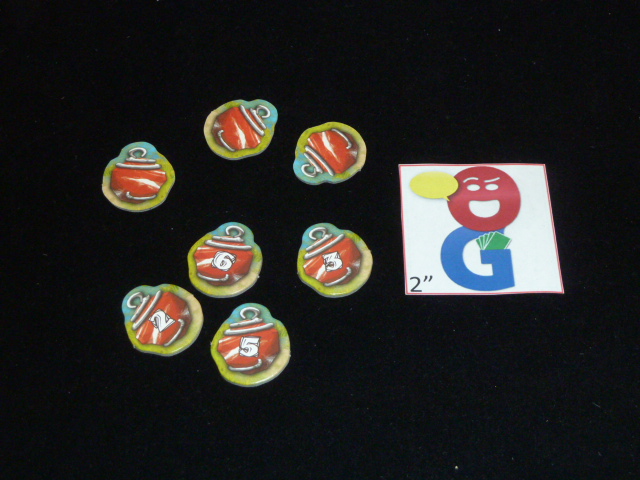
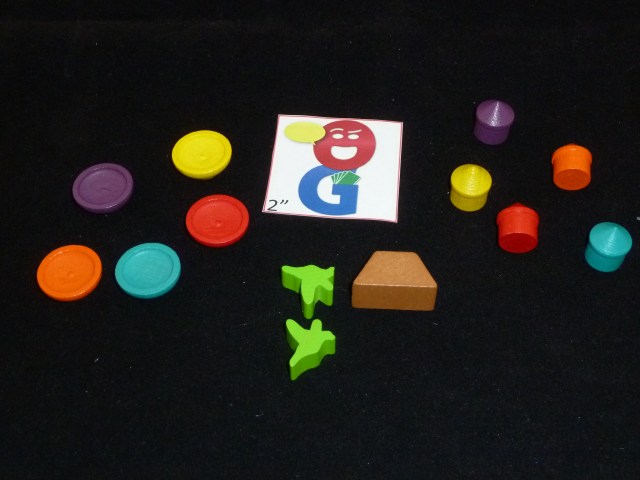
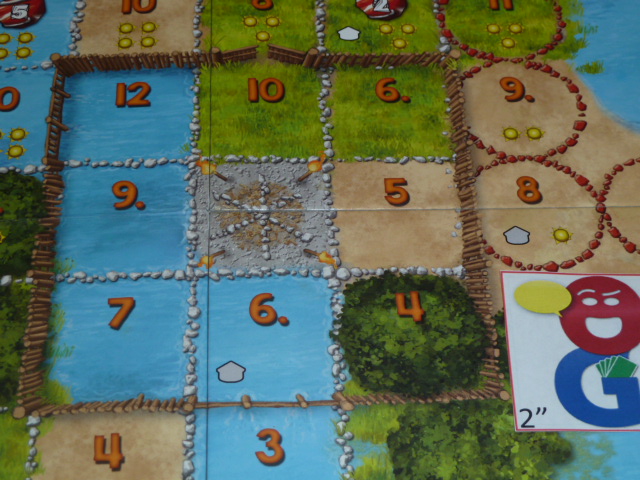
I played this with Joe H and he went essentially purely for collecting amulets. In the end, the game seemed close and competitive, but when the scores were tallied, Joe had completely crushed everyone else. I don’t know if the strategy is broken, but that result was certainly off-putting for a first attempt at the game.
Have any of you had any experience with people attempting that strategy?
Yes, I have tried that strategy myself. It is a bit table dependent. If only one person is left alone to collect amulets, then that person might be able to score well. But – you have to be fairly successful at getting the amulet track building spaces as well.
I’ve not been able to “run away” with a victory though. In the one game where I really tried to concentrate on the amulets, another player was able to get most of the stone area spots. I think 6 spaces x 8 pts each (as well as contributions from some sacred path scoring) balanced out my amulet total in that particular game.
A colorful board and a slew of strategic decisions—sounds cool! I like the way that the various regions of the map interact with the basic mechanic. That action track looks like a killer mechanic. It reminds me of Order Markers from Heroscape or Maneuver Dials from X-wing. It’s a unique approach to a mechanic I’m quite fond of.
Thanks for a review which concisely describes a game that’s rather large.
Hello, the designer wrote in the bgg forum the following
https://boardgamegeek.com/thread/1256745/mangrovia-summary-overlooked-rules
‘All spaces are part of the majority score for one or two of the eight divine paths, EXCLUDING the four amulet spaces in the upper right corner and the bottom right stone area space.’
This isnt anywhere in the rules. So we just played it with counting every space in the row of column.
Oops, I misread it and the designer reacted. There is only one space in the stone area thats not in a column or row. The rest you count for the devine paths.